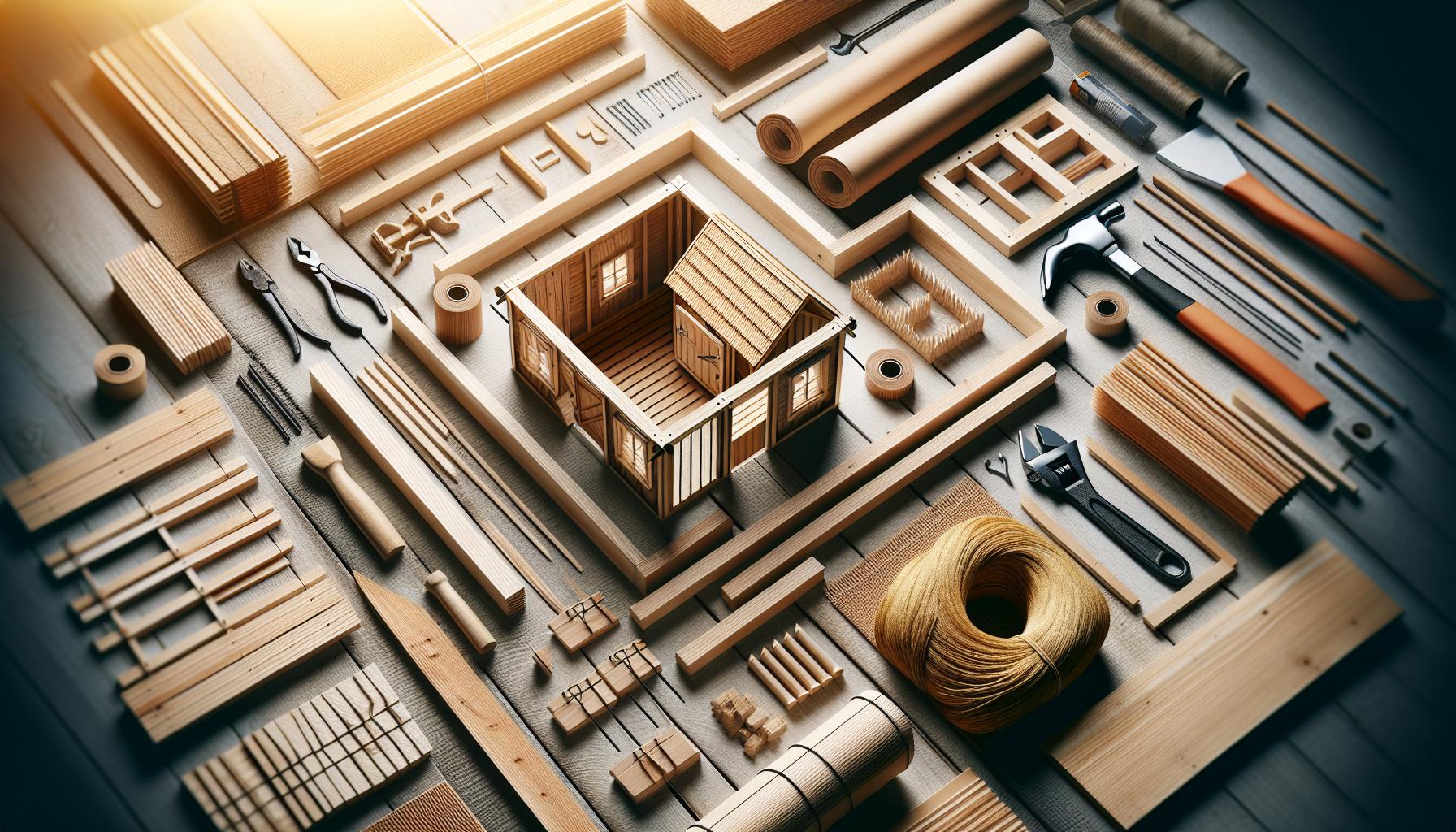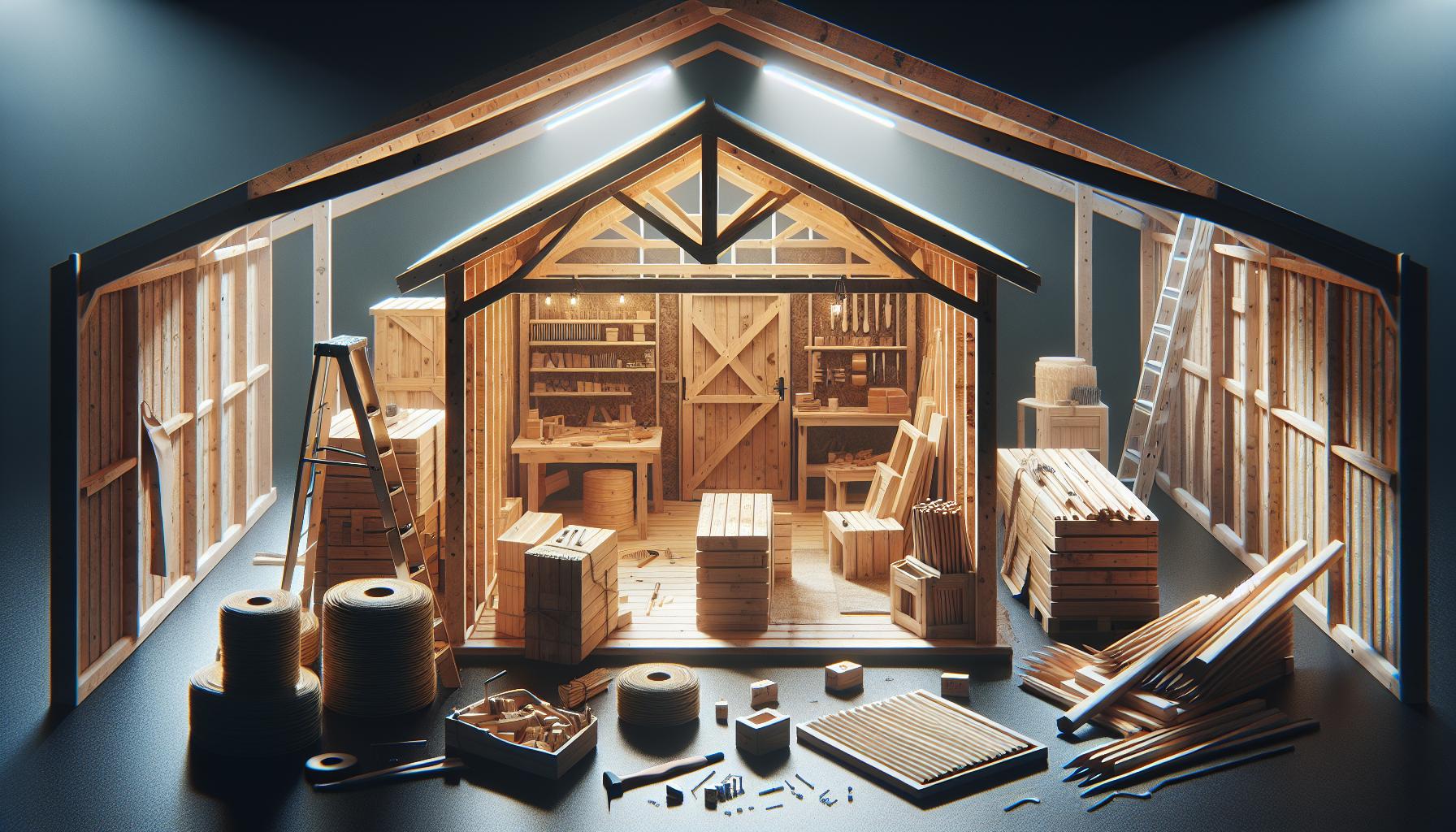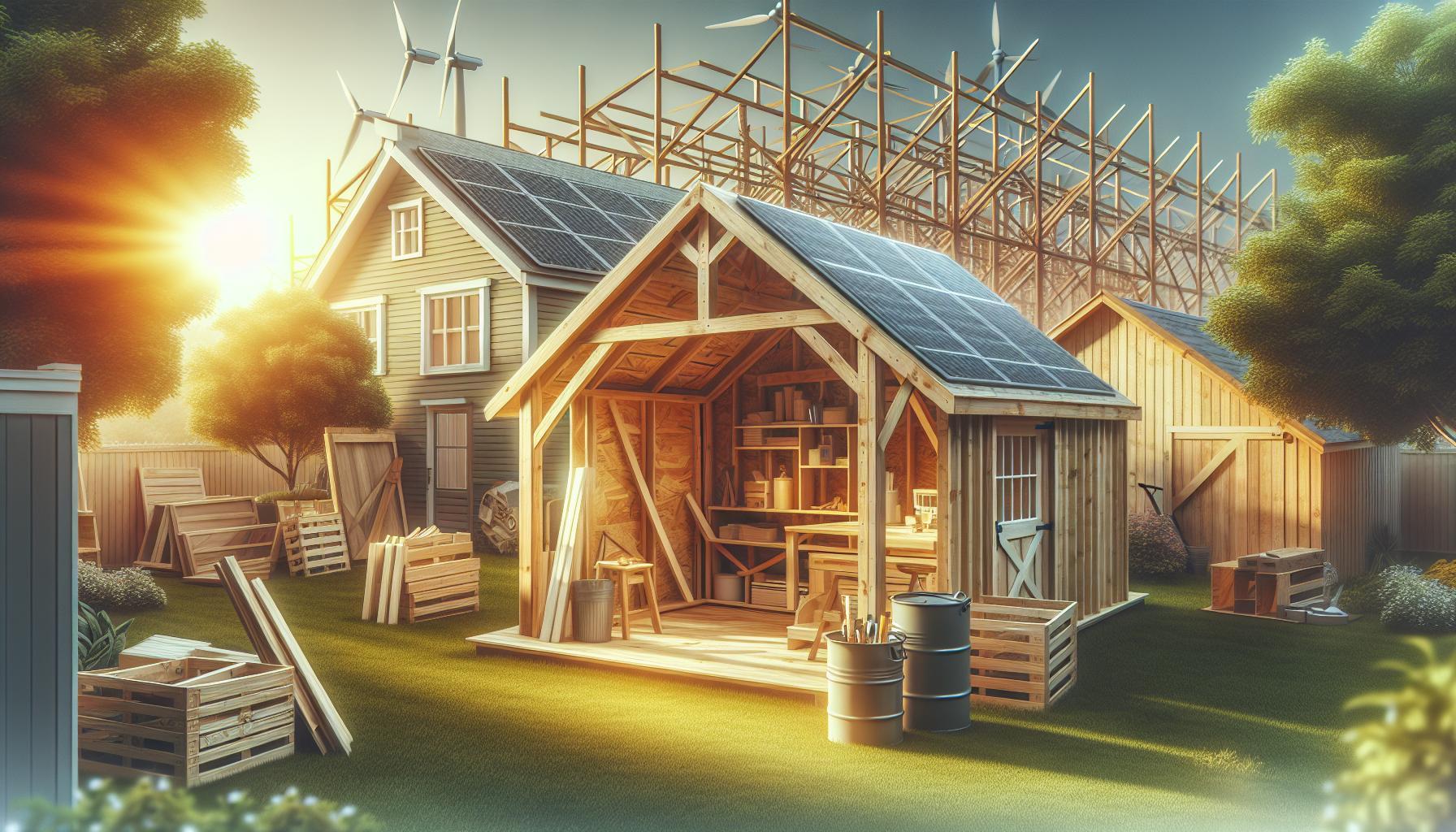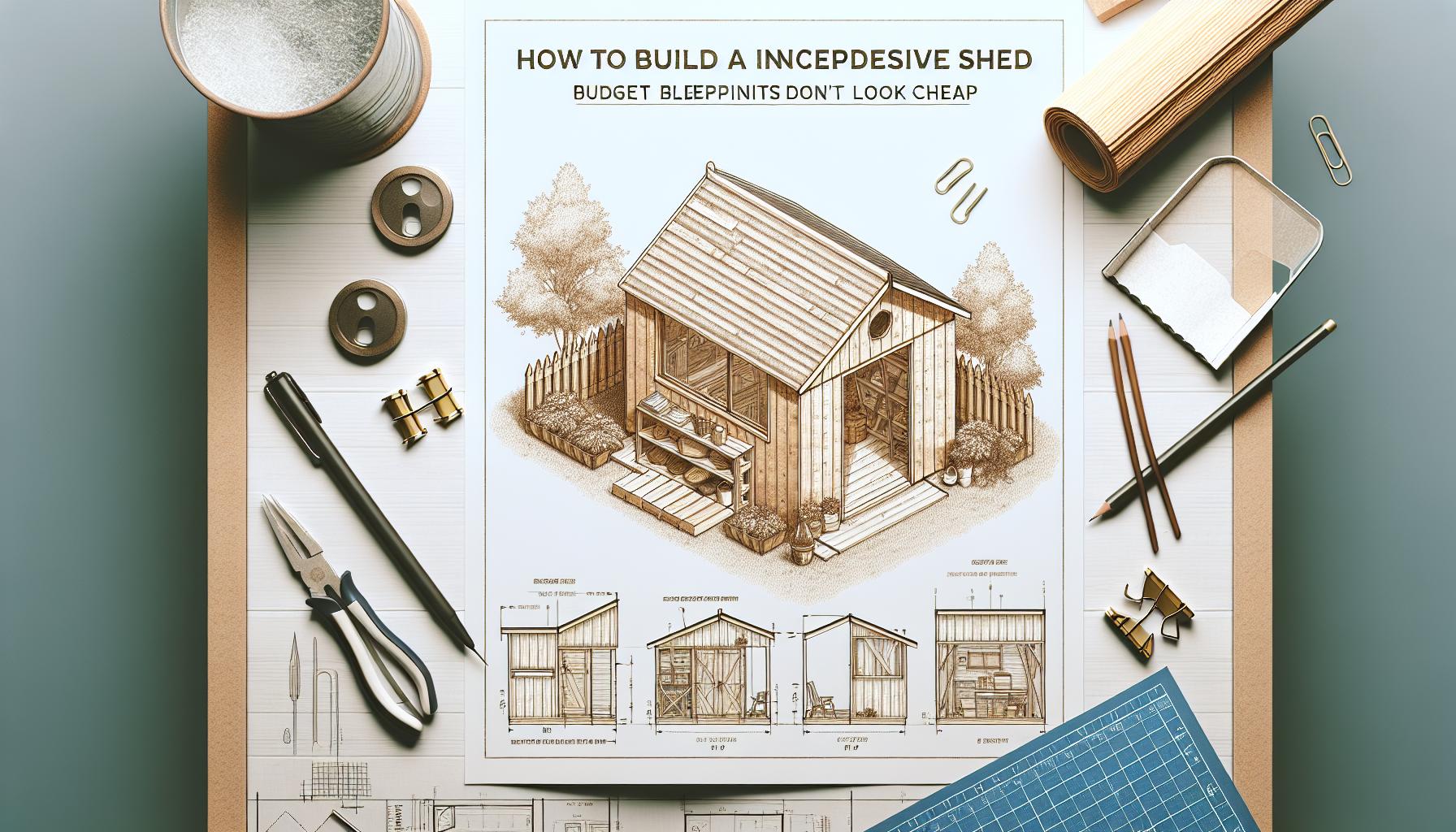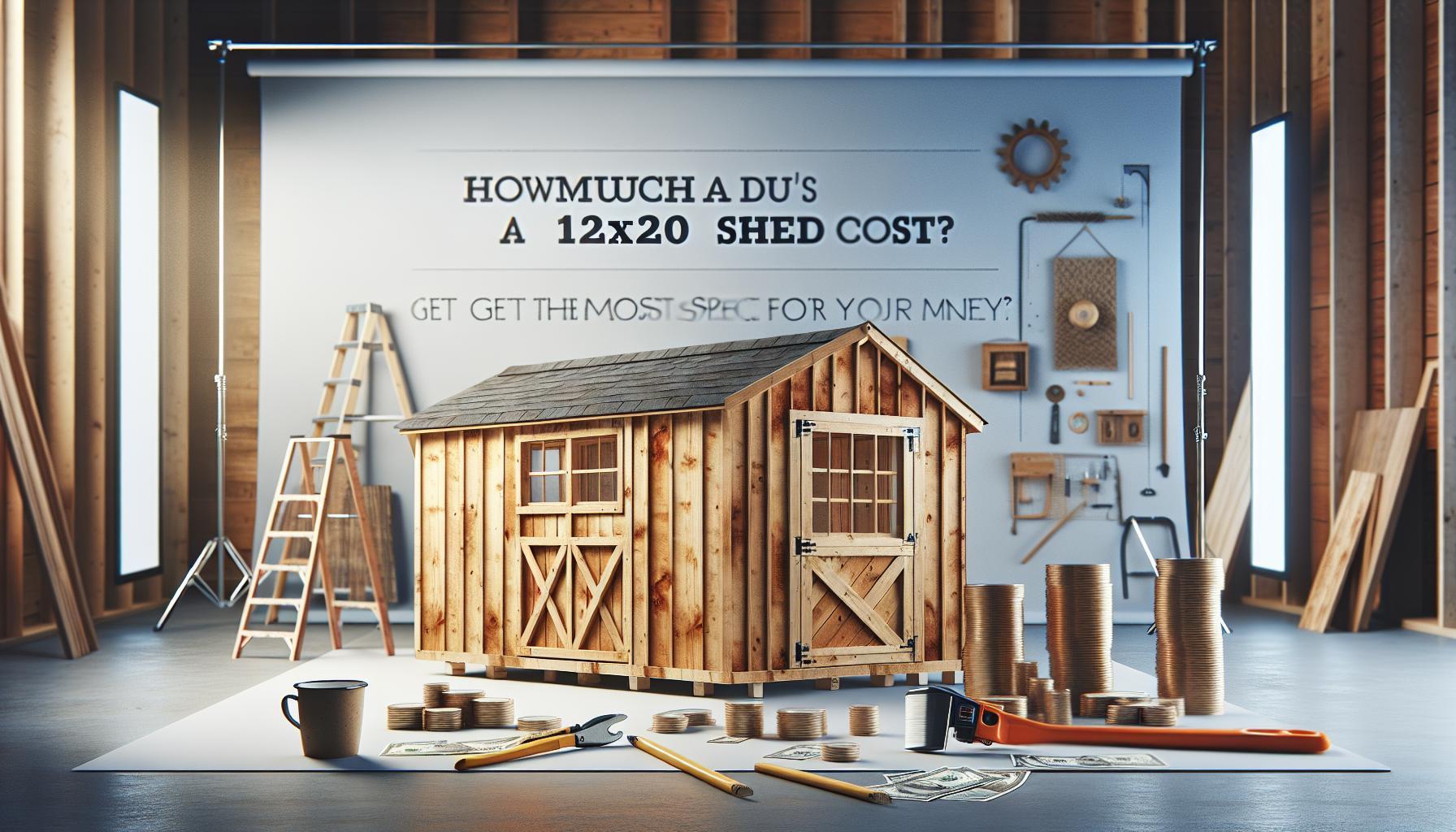When faced with teh need for extra storage or workspace, many people wrestle with a fundamental question: should you buy a pre-made shed or build one from scratch? Understanding the costs associated with each option is crucial, as it can impact your budget and satisfaction in the long run. This guide will help you navigate the financial implications, allowing you to make an informed decision.
Understanding the costs: Building vs.Buying a Shed
Understanding the financial implications of consolidating your outdoor storage needs can be quite a puzzle. With the rising costs of materials and labor, many homeowners are left pondering a crucial question: Is it cheaper to build or buy a shed? This cost comparison guide delves into the intricacies of each option, allowing you to make an informed decision tailored to your budget and requirements.
When considering the costs associated with building a shed, homeowners should factor in several elements that can significantly impact the overall expenditure. Below are the primary components that contribute to the cost of a DIY shed:
- Materials: depending on the type of wood or materials you choose, costs can vary widely. Basic plywood and untreated lumber are on the lower end, while cedar or treated wood significantly increases the price.
- Tools: If you don’t already own essential tools like saws, drills, and ladders, this upfront investment can add to your budget.
- Labor: If you’re tackling the project solo, labor costs might be nil, but if you’re hiring help, ensure to include that in your calculations.
- Permits: Some localities might require permits for construction, which could add an extra layer of cost to the DIY approach.
Conversely, purchasing a pre-constructed shed has its own set of expenses that need to be broken down. While the upfront costs might seem straightforward, additional considerations may arise:
Factors Affecting the Purchase Price
- Shed Size: Larger structures naturally command a higher price, while smaller sheds can be surprisingly budget-friendly.
- Materials and Design: Metal sheds tend to be cheaper than wooden ones, but aesthetics and custom sizes can increase costs.
- Delivery and setup Fees: Many retailers charge for delivery and may offer installation services at an additional cost.
To provide a clearer picture, here’s a simple comparison table to help visualize the potential costs associated with building versus buying a shed:
| Cost aspect | Building a Shed | Buying a Shed |
|---|---|---|
| Materials | $300 – $800 | $500 – $3,000 |
| Tools | $200 – $1,000 | N/A |
| Labor | $0 – $1,500 | $100 – $500 |
| Permits | $0 – $500 | N/A |
Ultimately, the decision largely hinges on two key factors: your budget and your capability to commit time and effort to a DIY project. By evaluating both methods’ financial implications and carefully weighing the options, you can navigate the often-overlooked question of whether it is more economical to build or buy a shed, leading to a solution that best meets your personal needs and financial situation.
The DIY Advantage: When to Build Your Own Shed
Building your own shed can be a fulfilling and cost-effective solution for many homeowners. Not only does it offer an opportunity for personal expression through custom design and material choices, but it also allows for greater control over costs. Understanding when to opt for the DIY route can be pivotal in ensuring you achieve maximum value for your investment.
Cost Savings and Customization
One of the primary reasons for choosing to build your own shed is the potential for important savings. When comparing expenses through the lens of the “Is It Cheaper to Build or Buy a Shed? Cost Comparison Guide,” building your shed can often be more affordable,notably if you already possess some of the necessary tools and skills. Here are a few factors to consider that may tilt the scale in favor of DIY:
- Material Choice: By sourcing your materials, you can often find deals on wood, roofing, and hardware that significantly reduce costs.
- Design Versatility: Customizing your shed to fit your specific needs means you won’t have to pay for features you don’t want or need.
- Labor Costs: Tackling the project solo—or with friends—eliminates the need to hire contractors, which can represent a substantial portion of the total expense.
Skill development and Personal Satisfaction
Building a shed is not only a budget-conscious decision but also a fantastic opportunity to enhance your DIY skills. Many homeowners find satisfaction in crafting something with their own hands, which adds an invaluable emotional component to the project. You can learn critically important construction skills, from basic carpentry to advanced project management, which could benefit other home improvement efforts in the future.
Space to Experiment
Construction permits the freedom to experiment with layouts and aesthetics that suit your personal taste or gardening needs. Such as, you can create compartments for garden tools, incorporate windows for natural light, or even add a small workspace for hobbies. Ultimately, if you’re prepared to invest time and motivation, building your own shed can offer a rewarding, personalized solution that far outweighs the convenience of buying pre-fabricated options.
By engaging with the practical aspects of DIY, not only do you save on upfront costs, but you also gain a unique structure tailored to your lifestyle—all while enjoying the process of creation. Whether it’s a simple storage shed or a more elaborate garden retreat, the DIY route allows for a mix of economy, creativity, and personal growth.
pre-Made Sheds: Analyzing the Purchase Process
When considering the practicality of pre-made sheds, it’s essential to dive into the purchase process that can frequently enough determine overall satisfaction with your investment. While the allure of custom-built options might tempt some, many homeowners find great value in the efficiency and predictability of purchasing a pre-made shed. This choice can not only save time but also provide clarity in budgeting, making the decision between building and buying easier to navigate.
Understanding Your Options
Before making a decision, it’s crucial to understand the various types of pre-made sheds available. Buyers can choose from a range of materials,styles,and sizes,each tailored to specific needs. Here are some common shed materials:
- Wood: Offers charm and versatility but may require more maintenance.
- Metal: Known for durability and low maintenance, but can be less visually appealing.
- Vinyl: Provides a balance of aesthetics and low upkeep with resistance to mold and decay.
Each of these options comes with its own set of advantages and disadvantages, which should be weighed carefully. The initial costs are a significant factor, but longer-term expenses associated with maintenance and repairs should also be considered.
The Purchase Process
When evaluating the purchase process of a pre-made shed, there are several steps that can streamline your experience. To facilitate effective research, consider the following:
Research Pricing and Suppliers
start with complete price comparisons across different suppliers to establish a reasonable budget.Websites and local hardware stores can provide valuable insights into the features and pricing of various designs. Creating a simple comparison table can definitely help visualize these options:
| Supplier | Material | Size (sq ft) | Price |
|---|---|---|---|
| Supplier A | Wood | 100 | $1,500 |
| supplier B | Metal | 120 | $1,200 |
| Supplier C | Vinyl | 100 | $1,800 |
Visit Showrooms
Once you’ve narrowed down your preferences, visiting local showrooms or suppliers can be beneficial. This hands-on experience allows you to inspect the quality of the materials and craftsmanship. Being able to see and feel the shed in person ensures that you are cozy with your choice before making a financial commitment.
Make an Informed Decision
Furthermore, consider the delivery and installation options offered by the supplier. many companies provide free delivery and setup services, adding significant value to your purchase. Check if they have customer reviews or testimonials that highlight the reliability of their delivery schedule and installation quality.
By understanding the purchase process for pre-made sheds, you empower yourself to make an informed decision that aligns with your budget and needs. As you weigh whether it’s cheaper to build or buy a shed, this analysis equips you with practical insights, ultimately leading to a satisfying transaction.
Hidden Expenses in Building a shed: What to Consider
When considering the costs associated with constructing a shed, it’s easy to focus solely on the visible expenses like materials and labor. However, there are numerous hidden expenses that can quickly inflate your budget.Understanding these potential financial pitfalls is essential, especially when contemplating whether to build or buy a shed, as highlighted in the comprehensive cost comparison guide.
One major hidden cost is site planning. Depending on the location of your shed, you may need to level the ground, remove debris, or even pour a concrete foundation. Such preparation work can involve additional labor and materials that must be factored into your overall budget. Moreover, if you’re installing electricity or plumbing, the costs escalate even further due to the need for proper wiring or piping installations.
Factors that Contribute to Hidden Expenses
- Permits and regulations: Check your local zoning laws and building codes.Frequently enough, permits come with fees and can also require specific inspections, all of which add to the cost.
- tools and Equipment: If you plan to construct the shed yourself, consider the costs of tools you may not own. Renting or purchasing tools can significantly impact your budget.
- Materials Variability: prices for lumber and other materials fluctuate due to market conditions. Always budget for a contingency in case prices rise unexpectedly.
- Finishes and Upgrades: Basic sheds are rarely sufficient. Most homeowners want to upgrade to better doors, windows, and finishes, which can add to the total expenditure.
To give you a clearer picture of how these hidden expenses can accumulate, consider the following basic table that outlines common costs involved in building a shed versus buying one:
| Cost Factors | Building a Shed | buying a Shed |
|---|---|---|
| Materials | Variable depending on type and size | Fixed cost for pre-manufactured options |
| Labor | DIY or hire a contractor | Included in purchase price |
| Permits | Perhaps high if required | Typically handled by the seller |
| Site preparation | Can be significant | Minimal if installed by professionals |
| Tools | May need to purchase/rent | No additional tool cost |
By budgeting for these hidden costs, you can make a more informed decision when pondering, “Is it cheaper to build or buy a shed?” A clear understanding of what to expect will help ensure that your shed project remains not only within budget but also meets your needs effectively.
Comparing Material Costs: Quality Choices for Your Shed
building a shed is more than just a weekend project; it’s a financial decision that can influence your property value and personal satisfaction. choosing the right materials is crucial to balancing quality and cost,affecting everything from durability to maintenance. The question often arises: how do the prices compare between purchasing a pre-made shed and constructing one from scratch? This makes a significant difference in your overall expenditure, and understanding material costs is a vital part of this decision-making process.
When diving into the cost comparisons, consider the types of materials available. Typically, contractors and DIY enthusiasts might choose between wood, metal, and plastic as primary materials for sheds.Each type has its pros and cons:
Material Breakdowns
- Wood: Classic aesthetic appeal and insulation properties; costs vary widely based on the type of wood. Treated lumber is more expensive but offers increased longevity.
- Metal: Contemporary look and high durability; requires less maintenance but may offer poor insulation.
- Plastic: Often the least costly and very easy to assemble; might lack the robustness of wood or metal options.
Additionally, it’s important to factor in other costs associated with the materials. As a notable example, if you choose wood, you should account for additional items such as sealants or paints to protect against weather conditions, which can add to the overall price. On the other hand, prefabricated sheds may come with built-in warranties and lower overall maintenance costs, offering a different kind of value.
To visualize the differences in expenses and make an informed decision,here’s a simplified comparison table:
| Material Type | Average Cost per Square Foot | Estimated Lifespan | Maintenance Requirements |
|---|---|---|---|
| Wood | $10-$25 | 15-30 years | High – require periodic painting/staining |
| Metal | $15-$30 | 30+ years | Low – minimal upkeep needed |
| Plastic | $5-$15 | 10-20 years | Very Low – easy to clean |
whether you’re debating whether it’s cheaper to build or buy a shed,understanding material costs can greatly influence your choices. Consider not only the upfront cost but also the long-term ownership experience. Investing in quality materials might seem more expensive initially, but the longevity and reduced maintenance can lead to savings over time, making it a worthy consideration in your shed-building journey.
Your Space, Your Needs: Customized Solutions vs. Ready-Made
In the quest for the perfect storage solution, many homeowners grapple with a pivotal decision: should they opt for a customized shed that meets their specific needs, or settle for a ready-made model that promises convenience? The revelation often lies in understanding the unique perks and potential drawbacks of both choices—each tailored to different priorities and budgets. While a ready-made shed might appear more cost-effective upfront,the real question is whether it can adequately accommodate your storage requirements or lifestyle.
Emphasizing Your Unique Needs
When contemplating whether to build or buy a shed,it’s crucial to recognize that customization allows for a design that fits your precise specifications. Custom-built sheds can be tailored to dimensions, materials, and features that align with your preferences. For example, you might require additional shelving for gardening supplies or a larger space for outdoor equipment, which a ready-made option may not provide without costly modifications. Investing in a customized solution means ensuring that every inch of space serves your purpose effectively, thereby maximizing the utility of your investment.
- Space Efficiency: Customize dimensions to fit your property perfectly.
- Unique Features: Add built-in shelves, electrical outlets, and other enhancements.
- Materials Selection: Choose from a variety of materials suited to your climate and aesthetic preferences.
Cost Considerations and Flexibility
While a ready-made shed often comes at a lower initial cost, it’s essential to consider long-term expenses associated with modifications and potential inefficiencies. According to the “Is It Cheaper to Build or Buy a Shed? Cost Comparison Guide,” the upfront savings from purchasing a ready-made unit may be countered by additional costs from customization later on if your needs change. Moreover, customized solutions tend to be more adaptable; if your storage needs evolve, a bespoke shed can be modified more easily than a standard model.
| Factor | Customized Shed | Ready-Made Shed |
|---|---|---|
| Initial Cost | higher | Lower |
| Long-term Adaptability | High | Low |
| Space Utilization | Optimized | Generalized |
| Time to Assemble | Longer | Shorter |
Ultimately, the choice between customized solutions and ready-made options hinges on an honest evaluation of your priorities—whether that be cost, functionality, or personal preference. Investing time in understanding what will serve your needs best can lead to a more satisfying purchase and a better-suited space in your backyard.
Time Investment: How Labor Affects Overall Costs
When considering whether to build or buy a shed, the labor involved can significantly affect overall costs. The time you allocate to this project not only influences your personal investment in terms of effort but also can lead to variable financial implications, depending on whether you’re hiring labor or undertaking the project yourself.
Assessing the total cost of labor involves understanding the time commitment required for each option. For instance,if you choose to build the shed yourself,you’ll need to factor in the hours spent on planning,gathering materials,and the actual construction. Depending on your skill level, this could range from a few weekends to several weeks. Each hour invested represents an opportunity cost, which is the economic principle that highlights what you forego in terms of other productive activities while engaged in shed construction.
On the other hand, outsourcing the labor to professional builders changes the equation. While it may seem like a quicker option, professional services come at a premium. Here’s a simple breakdown of potential labor costs to consider:
| Option | Estimated hours Needed | hourly Rate | Total Cost |
|---|---|---|---|
| DIY Build | 40 hours | $0 (personal time) | $0 |
| Professional builder | 10 hours | $50 | $500 |
Ultimately, the choice between building and buying depends on your available time, the value you place on your leisure activities, and your budgetary constraints. By thoroughly evaluating the labor aspect, you will be better equipped to determine whether opting for a DIY solution or hiring a professional aligns more closely with your financial and personal goals. Investing time wisely in the context of the ‘Is It Cheaper to Build or Buy a shed? Cost Comparison Guide’ can lead to significant savings or necessary expenditures, so approach the decision with careful consideration of these factors.
navigating Local Regulations: What You need to Know Before Building
Building your own shed can seem like an exciting and cost-effective project, but the road to realizing that dream can be quite winding if you’re not careful. Before you dive into the construction phase, understanding local regulations is essential. Regulations vary widely depending on where you live,and neglecting them can result in costly fines or even the necessity to dismantle your new structure.So, what do you need to know to navigate this important aspect?
Understand Zoning Laws
Local zoning laws dictate what structures can be built in your area and their specific uses. These regulations can vary not just from city to city, but also within different neighborhoods. before starting your shed project, you should:
- Check with your local zoning office to understand the restrictions.
- Investigate whether you need a permit for your shed. Factors influencing this might include the size of the shed and proximity to property lines.
- Confirm if there are any specific guidelines about building materials or aesthetics that must be adhered to.
Permits: Are They Necessary?
In many jurisdictions, constructing a shed requires a building permit, while in others, smaller sheds may fall under exemptions. Here’s a quick breakdown of what to consider regarding permits:
| Type of Shed | Permit Required? | Notes |
|---|---|---|
| Small (under 50 sq ft) | No | Generally considered temporary storage. |
| Medium (50 – 120 sq ft) | Varies | Check local regulations; some may allow without permit. |
| Large (over 120 sq ft) | Yes | Typically requires structural plans and inspections. |
Homeowners Association (HOA) Regulations
If your property is governed by a Homeowners Association, additional guidelines may apply. HOAs frequently enough have stricter rules than local zoning laws, and you might potentially be required to submit plans for approval prior to beginning your project. To ensure compliance, consider these steps:
- Review your HOA’s architectural guidelines, which can usually be found on their website or in your community handbook.
- submit any required forms or applications, detailing your proposed shed design, materials, and dimensions.
- Be prepared to make adjustments based on feedback to align with the community’s aesthetic standards.
By taking the time to research and comply with local regulations,you ensure not only the integrity and legality of your build but also contribute to a positive relationship with your neighbors and community authorities. this preparedness can ultimately lead to a smoother building process and may save you money,especially as you navigate the complexities surrounding the decision of whether building or buying a shed is indeed cheaper.
Q&A
Is it cheaper to build or buy a shed?
Generally, it can be cheaper to build a shed yourself. The total cost varies based on materials, labor, and your DIY skills. If you opt for a pre-built shed,factor in additional expenses like delivery and setup.
For a DIY project, you can save significantly on labor costs and choose materials that fit your budget. However, you need to consider your time investment and available tools.On the other hand, buying a shed may save you the hassle of construction, making it a better option if you’re short on time or skill.
what is included in the cost comparison guide for building vs. buying a shed?
The cost comparison guide examines materials, labor, and additional expenses. It provides a breakdown of each option, helping you make an informed decision.
Key factors like site preparation,permits,and customization costs are also considered. By analyzing all these elements together,the guide highlights the trade-offs between building a shed from scratch and purchasing a pre-manufactured one,ensuring you have a clearer understanding of the total investment.
Can I save money by using recycled materials to build my shed?
yes, using recycled materials can significantly reduce building costs. Creative use of reclaimed wood, doors, and windows not only saves money but also gives your shed a unique character.
Keep in mind that not all recycled materials are suitable for every project, so assessing their condition is essential. Additionally, check local regulations to ensure your rebuild complies with safety standards. If you need more tips on sourcing affordable materials, explore our other articles on shed building.
why does buying a shed frequently enough include hidden costs?
Hidden costs of buying a shed can include delivery, assembly, and additional features. Manufacturers frequently advertise a base price, which may not cover all expenses you’ll encounter.
Be vigilant about fees such as installation charges or site preparation costs that can add up quickly. Also,consider maintenance requirements for pre-built sheds,which may differ from a DIY option. Always read the fine print before making a purchase to avoid unexpected expenses.
How do I determine the size of shed I need?
Determining shed size starts with assessing your storage needs. Consider what items you’ll store and if you’ll need room for future expansion or workspace.
Also, measure the intended site and account for local building codes. Typical sizes range from small garden sheds to large workshops, so ensuring adequate space can help you avoid costly modifications later. Utilize online calculators and design tools to visualize your ideal shed layout.
What factors should I consider when deciding between building and buying a shed?
Key factors include budget, skill level, and intended use. Assess your financial situation to see if you can afford materials and potential labor costs for a DIY shed.
Your personal skill set is crucial too; if you are a novice,purchasing might potentially be a more reliable option. Additionally, consider how you plan to use the shed, which can impact your ideal materials and design choices for either route.
Can I customize a pre-built shed like I can with a DIY shed?
Yes, many manufacturers offer customization options for pre-built sheds. However, the extent of customization can vary significantly between brands.
Common options include size, color, and added features like windows and doors. Be prepared that certain customizations may also lead to a higher price point; thus, ensuring alignment with your budget is crucial. Understanding the flexibility of each option can guide your decision.
in Retrospect
deciding whether to build or buy a shed involves careful consideration of costs, time, and personal skill levels. Our comprehensive guide has outlined the essential factors to help you make an informed choice. Remember, while buying offers instant gratification, building your own shed can be a rewarding endeavor that gives you more control over design and materials, frequently enough leading to greater long-term value.
Don’t hesitate to explore your options further—whether through local materials, DIY tutorials, or even workshops in your community. Embrace the learning process and take pride in your craftsmanship, no matter your experience level. By weighing your preferences for customization and cost-efficiency, you can turn your shed project into a fulfilling challenge that enhances your outdoor space. Ready to get started? Dive into the necessary plans, gather your tools, and take that exciting first step toward your new shed!


